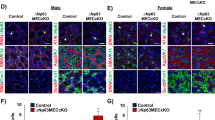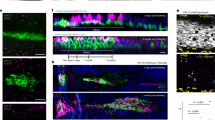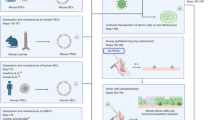Abstract
Cellular plasticity contributes to the regenerative capacity of plants, invertebrates, teleost fishes and amphibians. In vertebrates, differentiated cells are known to revert into replicating progenitors, but these cells do not persist as stable stem cells. Here we present evidence that differentiated airway epithelial cells can revert into stable and functional stem cells in vivo. After the ablation of airway stem cells, we observed a surprising increase in the proliferation of committed secretory cells. Subsequent lineage tracing demonstrated that the luminal secretory cells had dedifferentiated into basal stem cells. Dedifferentiated cells were morphologically indistinguishable from stem cells and they functioned as well as their endogenous counterparts in repairing epithelial injury. Single secretory cells clonally dedifferentiated into multipotent stem cells when they were cultured ex vivo without basal stem cells. By contrast, direct contact with a single basal stem cell was sufficient to prevent secretory cell dedifferentiation. In analogy to classical descriptions of amphibian nuclear reprogramming, the propensity of committed cells to dedifferentiate is inversely correlated to their state of maturity. This capacity of committed cells to dedifferentiate into stem cells may have a more general role in the regeneration of many tissues and in multiple disease states, notably cancer.
This is a preview of subscription content, access via your institution
Access options
Subscribe to this journal
Receive 51 print issues and online access
$199.00 per year
only $3.90 per issue
Buy this article
- Purchase on SpringerLink
- Instant access to full article PDF
Prices may be subject to local taxes which are calculated during checkout





Similar content being viewed by others
References
Wolff, G. EntwicklungsphysiologischeStudien. I. Die Regeneration der Urodelenlinse. Arch. Entwickl. Mech. Org. 1, 380–390 (1895)
Brockes, J. P. & Kumar, A. Plasticity and reprogramming of differentiated cells in amphibian regeneration. Nature Rev. Mol. Cell Biol. 3, 566–574 (2002)
Kai, T. & Spradling, A. Differentiating germ cells can revert into functional stem cells in Drosophila melanogaster ovaries. Nature 428, 564–569 (2004)
Slack, J. M. W. Metaplasia and transdifferentiation: from pure biology to the clinic. Nature Rev. Mol. Cell Biol. 8, 369–378 (2007)
Kragl, M. et al. Cells keep a memory of their tissue origin during axolotl limb regeneration. Nature 460, 60–65 (2009)
Lehoczky, J. A., Robert, B. & Tabin, C. J. Mouse digit tip regeneration is mediated by fate-restricted progenitor cells. Proc. Natl Acad. Sci. USA 108, 20609–20614 (2011)
Rinkevich, Y., Lindau, P., Ueno, H., Longaker, M. T. & Weissman, I. L. Germ-layer and lineage-restricted stem/progenitors regenerate the mouse digit tip. Nature 476, 409–413 (2011)
Sugimoto, K., Gordon, S. P. & Meyerowitz, E. M. Regeneration in plants and animals: dedifferentiation, transdifferentiation, or just differentiation? Trends Cell Biol. 21, 212–218 (2011)
Wang, X. et al. A luminal epithelial stem cell that is a cell of origin for prostate cancer. Nature 461, 495–500 (2009)
Van Keymeulen, A. et al. Distinct stem cells contribute to mammary gland development and maintenance. Nature 479, 189–193 (2011)
Jopling, C. et al. Zebrafish heart regeneration occurs by cardiomyocyte dedifferentiation and proliferation. Nature 464, 606–609 (2010)
Jopling, C., Boue, S. & Izpisua Belmonte, J. C. Dedifferentiation, transdifferentiation and reprogramming: three routes to regeneration. Nature Rev. Mol. Cell Biol. 12, 79–89 (2011)
vanEs, J. H. et al. Dll1+ secretory progenitor cells revert to stem cells upon crypt damage. Nature Cell Biol. 14, 1099–1104 (2012)
Dabeva, M. D. et al. Liver regeneration and α-fetoprotein messenger RNA expression in the retrorsine model for hepatocyte transplantation. Cancer Res. 58, 5825–5834 (1998)
Brawley, C. & Matunis, E. Regeneration of male germline stem cells by spermatogonial dedifferentiation in vivo. Science 304, 1331–1334 (2004)
Cheng, J. et al. Centrosome misorientation reduces stem cell division during ageing. Nature 456, 599–604 (2008)
Hsu, Y., -C, Pasolli, H. A. & Fuchs, E. Dynamics between stem cells, niche, and progeny in the hair follicle. Cell 144, 92–105 (2011)
Song, H. et al. Functional characterization of pulmonary neuroendocrine cells in lung development, injury, and tumorigenesis. Proc. Natl Acad. Sci. USA 109, 17531–17536 (2012)
Rawlins, E. L. et al. The role of Scgb1a1+ Clara cells in the long-term maintenance and repair of lung airway, but not alveolar, epithelium. Cell Stem Cell 4, 525–534 (2009)
Rock, J. R. et al. Basal cells as stem cells of the mouse trachea and human airway epithelium. Proc. Natl Acad. Sci. USA 106, 12771–12775 (2009)
Rock, J. R. & Hogan, B. L. M. Epithelial progenitor cells in lung development, maintenance, repair, and disease. Annu. Rev. Cell Dev. Biol. 27, 493–512 (2011)
Diamond, I., Owolabi, T., Marco, M., Lam, C. & Glick, A. Conditional gene expression in the epidermis of transgenic mice using the tetracycline-regulated transactivatorstTA and rTA linked to the keratin 5 promoter. J. Invest. Dermatol. 115, 788–794 (2000)
Weber, T. et al. Inducible gene expression in GFAP+ progenitor cells of the SGZ and the dorsal wall of the SVZ—a novel tool to manipulate and trace adult neurogenesis. Glia 59, 615–626 (2011)
Tata, P. R. et al. Airway specific inducible transgene expression using aerosolized doxycycline. Am. J. Respir. Cell Mol. Biol. http://dx.doi.org/10.1165/rcmb.2012-0412OC (12 July, 2013)
Miller, R. L. et al. V-ATPase B1-subunit promoter drives expression of EGFP in intercalated cells of kidney, clear cells of epididymis and airway cells of lung in transgenic mice. Am. J. Physiol. Cell Physiol. 288, C1134–C1144 (2005)
Kim, J. K. et al. In vivo imaging of tracheal epithelial cells in mice during airway regeneration. Am. J. Respir. Cell Mol. Biol. 47, 864–868 (2012)
Cho, J. L. et al. Enhanced Tim3 activity improves survival after influenza infection. J. Immunol. 189, 2879–2889 (2012)
Briggs, R. & King, T. J. Transplantation of living nuclei from blastula cells into enucleated frogs’ eggs. Proc. Natl Acad. Sci. USA 38, 455–463 (1952)
Gurdon, J. B., Elsdale, T. R. & Fischberg, M. Sexually mature individuals of Xenopus laevis from the transplantation of single somatic nuclei. Nature 182, 64–65 (1958)
Blanpain, C. Tracing the cellular origin of cancer. Nature Cell Biol. 15, 126–134 (2012)
Schwitalla, S. et al. Intestinal tumorigenesis initiated by dedifferentiation and acquisition of stem-cell-like properties. Cell 152, 25–38 (2013)
Friedmann-Morvinski, D. et al. Dedifferentiation of neurons and astrocytes by oncogenes can induce gliomas in mice. Science 338, 1080–1084 (2012)
Visvader, J. E. Cells of origin in cancer. Nature 469, 314–322 (2011)
Goldstein, A. S., Huang, J., Guo, C., Garraway, I. P. & Witte, O. N. Identification of a cell of origin for human prostate cancer. Science 329, 568–571 (2010)
Sequist, L. V. et al. Genotypic and histological evolution of lung cancers acquiring resistance to EGFR inhibitors. Sci. Transl. Med. 3, 75ra26 (2011)
Acknowledgements
The work in this manuscript was supported by a Harvard Stem Cell Institute Seed Grant and a National Institutes of Health-National Heart, Lung, and Blood Institute Early Career Research New Faculty (P30) award (5P30HL101287-02) and a Harvard Stem Cell Institute (HSCI) Junior Investigator Grant to J.R. J.R. is a New York Stem Cell Foundation-Robertson Investigator. We wish to extend our thanks to W. Anderson, Y. Dor, Q. Zhou, A. Brack, J. Galloway and all members of the Rajagopal laboratory for their constructive criticism. We thank the members of the HSCI flow cytometry core facility for help with cell sorting.
Author information
Authors and Affiliations
Contributions
P.R.T. designed and performed experiments and wrote the manuscript; H.M., A.P.-S., R.Z., M.P., B.M.L. and V.V. performed ex vivo experiments; J.L.C. performed influenza infection experiments; A.S. provided tet(O)DTA mice and edited the manuscript; S.B. provided B1-eGFP mice; B.D.M. reviewed the manuscript; J.R. suggested and co-designed the study and co-wrote the manuscript with P.R.T.
Corresponding author
Ethics declarations
Competing interests
The authors declare no competing financial interests.
Extended data figures and tables
Extended Data Figure 1 Schematic representation of the dedifferentiation of luminal secretory cells into functional basal stem cells.
a, Differentiated luminal secretory cells are labelled with a YFP lineage tag in a homeostatic airway epithelium. Basal stem cells are then ablated using diphtheria toxin. In response, lineage-labelled secretory cells dedifferentiate into cells that morphologically resemble basal cells and express basal stem cell markers. These dedifferentiated basal-like cells respond to physiologically relevant toxic and infectious injury and serve as multipotent stem cells during epithelial regeneration. The inset depicts the different cell types of the airway epithelium. b, Graphical representation of the dedifferentiation potential of differentiated basal-like cells. x axis represents the maturity of a secretory cell; y axis represents the propensity for dedifferentiation to a basal-like cell. The propensity to dedifferentiate is inversely correlated to the maturity of the secretory cell.
Extended Data Figure 2 Inhaled doxycycline efficiently ablates basal stem cells of the airway epithelium.
a, Schematic representation of basal-cell-specific ablation using i-Dox. b, Co-labelling of p63 (green) and CK5 (red) on tracheal sections CK5-DTA mice that received either i-PBS (top) or i-Dox (middle and bottom panels show 2 and 3 doses of i-Dox, respectively). c, Co-labelling of NGFR (green) and T1α (red) i-PBS- or i-Dox-treated mice. d, Quantification of the number of p63+ (black bar) and CK5+ (grey bar) basal cells from CK5-DTA animals treated with PBS (p63, 1,229 ± 65.45; CK5, 1,376 ± 25.23), two doses of i-Dox (p63, 690 ± 35.13; CK5, 716 ± 12.44) or three doses of i-Dox (p63, 262 ± 29.5; CK5, 255 ± 46.82). y axis represents the absolute numbers of basal cells (from three independent tracheal sections). Dox(2) and Dox (3) refer to two and three doses of doxycycline inhalation, respectively. n = 3 (two mice per condition). Error bars, average ± s.e.m. Scale bars, 20 μm.
Extended Data Figure 3 Secretory cells begin to express proliferation and stem cell markers and undergo dedifferentiation following basal cell ablation.
a, Orthogonal confocal optical sections of SCGB1A1 (green), CK5 (cyan) and Ki67 (red) XY and XZ planes are shown to demonstrate the colocalization of Ki67 and SCGB1A1. b, Quantification of the percentage of Ki67+ CK8+ double-positive cells per total Ki67+ cells from i-PBS (23.74% ± 6.76)- and i-Dox (63.22% ± 4.14)-treated CK5-DTA mice. c, Co-labelling of CK5 and SCGB1A1 in i-Dox-treated CK5-DTA mice. White arrows, double-positive cells. d, Immunostaining for YFP (green) and Ki67 (red) on sections from SCGB1A1–YFP/CK5-DTA mice. White arrows indicate YFP+ Ki67+cells. e, Quantification of the percentage of YFP+Ki67+ cells per total Ki67+ cells in SCGB1A1–YFP/CK5-DTA mice that were treated with either i-Dox (31.74% ± 7.15) or i-PBS (9.65% ± 2.12). f, Co-labelling of YFP (green) with p63 or T1α (red) on tracheal sections of SCGB1A1–YFP/CK5-DTA mice that were either treated with i-PBS (top) or i-Dox (bottom). White arrows, double-positive cells. n = 3 (three mice per condition). Error bars, average ± s.e.m. Scale bars, 20 μm.
Extended Data Figure 4 Dissociation and fluorescence activated cell sorting of airway epithelial cells.
a, Schematic representation of tracheal epithelial cell dissociation from secretory cell lineage-labelled mice (SCGB1A1-CreER/LSL-YFP) after five doses of tamoxifen. Of the total epithelial cells, EPCAM+ CD24− cells were gated to remove ciliated cells. Then YFP+secretory cells and GSIβ4+ basal cells were sorted. b, Of the total epithelial cells, EPCAM+ CD24− cells were gated to remove ciliated cells (left). Then, YFP+ secretory cells were separated from GSIβ4+ basal cells (middle). Sorted YFP+ cells were also marked by the secretory cell marker SSEA-1 as expected for a pure population of SCG1A1+ cells (right).
Extended Data Figure 5 Sorted secretory cells dedifferentiate into basal-like self-renewing stem cells upon ex vivo culture.
a, Schematic representation of tracheal epithelial cell dissociation from basal cell reporter mice (CK5-rtTA/tet(O)H2BGFP) followed by sorting of GFP–SSEA-1+ secretory cells. Sorted SSEA-1+ cells were grown as spheres in Matrigel or plated on transwell membranes. Doxycycline was administered and cells were monitored for the initiation of GFP expression. b, Fluorescence-activated cell sorting of SSEA-1+ cells from basal cell reporter mice (CK5-rtTA/tet(O)H2BGFP). Arrows indicate gating windows. EPCAM is a pan-epithelial marker used to exclude non-epithelial lineages. Sorted SSEA-1+ secretory cells did not express GFP. c, Immunofluorescence staining for p63 (red; top) or CK5 (red; bottom) in combination with H2B–GFP (green; all panels) on sorted secretory cells that were either cultured as Matrigel spheres (left) or on transwells (right). Immunofluorescence analysis confirmed that H2B–GFP+ cells expressed p63 and CK5, again confirming that secretory cells dedifferentiate in culture. n = 3 (two replicates per condition). Scale bars, 20 μm.
Extended Data Figure 6 Sorted lineage-labelled secretory cells undergo dedifferentiation ex vivo, express basal stem cell markers, and can be serially passaged, as can secretory cells that underwent dedifferentiation in vivo.
a, Schematic representation of secretory cell labelling, sorting and subsequent culturing in Matrigel or on transwell membranes. b, Cell colonies obtained from early passage cultures of YFP+ secretory-cell-derived cells on transwell membranes. c, Immunostaining for CK5 (red), p63 (magenta) and YFP (green) on passage-five basal cell colonies from ex vivo-dedifferentiated cells. d, Schematic showing that YFP+ secretory-cell-derived spheres from SCGB1A1-CreER/LSL-YFP mice were serially passaged for five generations. e, Quantification of the sphere-forming efficiency: P1 (2.86% ± 0.65), P2 (3.36% ± 0.6), P3 (2.31% ± 0.32), P4 (2.75% ± 0.69) and P5 (2.7% ± 0.94). x axis, number of passages. y axis, percentage of spheres formed. f, Schematic representation of in vivo dedifferentiation followed by the sorting and culturing of YFP+ basal-like cells. g, Immunostaining for CK5 (red), p63 (magenta) and YFP (green) on passage-five cell colonies from in vivo-dedifferentiated cells. n = 3 (two replicates per condition). Error bars, average ± s.e.m. Scale bars, 20 μm.
Extended Data Figure 7 B1–eGFP transgenic mice express GFP in mature subsets of secretory cells.
a, Co-labelling of GFP (green) with CK5 or SCGB1A1 or SSEA-1 (all in red) on large airways sections derived from adult B1–eGFP transgenic mice at homeostasis. White arrows indicate SSEA-1+ B1–eGFP−, whereas white arrowheads point to cells that are B1–eGFP+ SSEA-1− (bottom). b, B1–eGFP trachea were stained for GFP (green) and SSEA-1 (red) on day 4 and day 6 after SO2-induced injury. n = 3 (two mice per condition per time point). Scale bars, 20 μm.
Extended Data Figure 8 Dedifferentiated basal-like stem cells are stable and self-renew to the same degree as endogenous basal stem cells.
a, Schematic representation of the dedifferentiation protocol to assess the ability of basal-like stem cells to persist and self-renew for 2 months. b, Immunofluorescence staining for YFP (green) in combination with CK5 (cyan) or Ki67 (red) on sections from SCGB1A1–YFP/CK5-DTA mice 2 months after basal cell ablation. c, Quantification of the percentage of proliferating dedifferentiated CK5+ YFP+ (10.16% ± 2.57) (green bar) and wild-type CK5+ YFP− (9.25% ± 0.79) (black bar) stem cells out of the total CK5+ stem cell population in the large airways of SCGB1A1–YFP/CK5-DTA mice 2 months after basal cell ablation. The white arrow points to a proliferating dedifferentiated basal-like stem cell. n = 3 (two mice per condition). Error bars, average ± s.e.m. Scale bar, 20 μm.
Extended Data Figure 9 SO2-and influenza-induced injury efficiently removes the suprabasal cells of the airway epithelium.
a, Immunofluorescence staining for CK5 (red) and YFP (green) in SCGB1A1–YFP/CK5-DTA airway epithelium 24 h after SO2 inhalation. Only a single layer of basal cells persists after injury. White arrows, CK5+ YFP+ double-positive cells (yellow). b, Immunofluorescence analysis of basal cells (CK5, red) and secretory cells (SCGB1A1, green) from uninjured (top), 72 hours post-infection (h.p.i.; middle) and 14 days post-infection (d.p.i.; bottom). White arrow, secretory cell debris (in green). n = 3 (two replicates per condition). Scale bars, 20 μm.
Extended Data Figure 10 Ex vivo-dedifferentiated cells can be clonally expanded and give rise to a complete airway epithelium in air–liquid interface cultures.
a, Schematic representation of the ex vivo dedifferentiation of secretory cells, serial passage and differentiation. b, Whole-mount immunostaining for YFP (green) in combination with CK5 or p63 or acetylated (AC)-tubulin (red). c, Co-labelling of YFP (green) with CK5 or p63 or SCGB1A1 or acetylated-tubulin (red) on differentiated epithelium derived from serially passaged dedifferentiated basal-like cells. d, Whole-mount immunofluorescence staining for SCGB1A1 (red) and acetylated-tubulin (green) on clonally derived epithelium (left). Co-labelling of YFP (green) with CK5 (white) and CK8 (red; top) or SCGB1A1 and FOXJ1 (bottom) on cross sections of clonally derived epithelium. Scale bars, 20 μm.
Rights and permissions
About this article
Cite this article
Tata, P., Mou, H., Pardo-Saganta, A. et al. Dedifferentiation of committed epithelial cells into stem cells in vivo . Nature 503, 218–223 (2013). https://doi.org/10.1038/nature12777
Received:
Accepted:
Published:
Issue Date:
DOI: https://doi.org/10.1038/nature12777
This article is cited by
-
A computational model of stem cells’ internal mechanism to recapitulate spatial patterning and maintain the self-organized pattern in the homeostasis state
Scientific Reports (2024)
-
Cell-fate conversion of intestinal cells in adult Drosophila midgut by depleting a single transcription factor
Nature Communications (2024)
-
Origins of cancer: ain’t it just mature cells misbehaving?
The EMBO Journal (2024)
-
Airway hillocks are injury-resistant reservoirs of unique plastic stem cells
Nature (2024)
-
A Systematic Review of Stem Cell Differentiation into Keratinocytes for Regenerative Applications
Stem Cell Reviews and Reports (2024)



